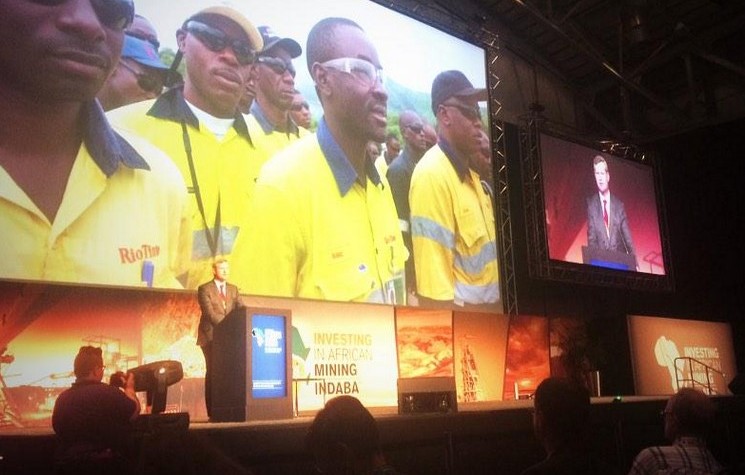An Industry That Is Bust? Sombre Atmosphere At This Year’s African Mining Indaba

By Bianca Markram in Cape Town
Since the African Mining Indaba started in 1995, the industry has lived through an unprecedented boom with a decade of unparalleled growth – and wealth.
But two decades later, the industry is at a juncture where many companies’ management and their investors have had to make hard decisions to ensure the preservation of value. There is a lot of talk at the 20th African Mining Indaba about “consolidating”, cost cuts, purging companies from inefficient or marginal projects, “care and maintenance”, “operational review”.
It is a time for “restraint” when you’re an investor, and a time of serious ”constraint” if you are on the other end.
Shortly before the industry walked through the revolving doors of the Cape Town International Convention Centre (CTICC) on February 9th, miners and their investors, both current and prospective, had to grapple with the shock of a massive drop in the copper price, an even more dramatic drop – the kind where the bottom falls out – in oil prices, while the iron ore dream pretty much turned dark already last year.
Ironically, South Africa, the hosting country for the Indaba, is grappling with its own series of shocks. The country’s power supplier Eskom is in the midst of a power crisis, unable to keep all the lights on all the time, having daily load shedding nationwide, including in Cape Town, where more than 7,000 people are converging for the Indaba.
Luckily, Eskom excludes any venue where big crowds gather from power cuts.
The country is also gearing up for the presidential State of the Nation address on the last day of the Indaba. President Jacob Zuma is facing the nation amid huge doubts over his leadership, one of these the prevailing uncertainty of when amendments to the country’s mining act will be passed and in what form.
Mining minister Ngoako Ramatlhodi said in his address at the Mining Indaba on February 10 that “our intention [is] to provide regulatory certainty for those who have invested here and those who plan to do so.”
After the legislation was pushed through Parliament last year in a bid to have it signed off before elections, president Zuma has now declined to give the proposed amended legislation his final nod, due to concerns that the Act could be constitutionally unsound. The proposals are now again under review, with Ramatlhodi a strong supporter of splitting out oil and gas into its own contained piece of legislation, separate from the country’s other minerals.
One of the biggest risk factors in South Africa today, however, is labour. Last year’s Indaba headlines were dominated by the platinum-belt strike that was then only approaching its second month. It would last until well into May that year, something that the South African economy and platinum producers are still reeling from.
During his keynote address, former UK Prime Minister Tony Blair noted that mining was not simply a transaction but the building of a relationship between governments, enterprises and the workforce.
Governments need to reduce red tape and be transparent, while companies need to take responsibility of the needs of the workers and the communities from which they come. Workers, in turn, need to recognise that they had an interest in working to make the company succeed.
This Indaba seems like any other year’s Indaba in many respects: manic, hectic, a maelstrom of people, cocktail parties. However, this year the atmosphere is sombre.
“An industry that is bust.” This was Mark Bristow in his scalding presentation of the mining industry on February 10.
“We all lived through an unprecedented boom…what did we do with this bounty? What did we save?” he asked. “We had a market value of US$2.3 trillion. Today we are worth less than half of this. A golden opportunity to create lasting value was missed. We can’t afford to do that again.”
Indeed, investors have all but run for the hills. They have virtually no appetite for mining. Certainly, from an equity perspective, initial public offerings (IPOs) have dried up. Some private equity investors still have appetite for mining projects, with most of the ones in development in Africa, but only the good projects that are near or in production.
“There’s a lot of gloom around,” said Lara Smith, managing director of Core Consultants. But she sees a market poised for some merger and acquisition action.
Every year there is talk of M&A. Glencore’s takeover of Xstrata certainly set the stage for that. But this is fast becoming possibly one of only very few options left to companies seeking funding for new and existing projects and, most importantly, for trimming costs.
Rumours surfaced again at the Indaba that trading house Traxys is in the process of buying its competitor Metmar. There had been whispers of that in the past weeks, although this has not been confirmed by either party.
Smith at Core Consultants believed it could well be a feasible marriage. And there will be others.
“It’s coming,” she said, but she believed the commodities market has to bottom before it would trigger M&A activity. This will be more likely towards the third or last quarter of this year.
Running parallel to the Indaba was the 121 Mining Investment meeting that also took place in Cape Town, deeper into the city. Here a small group of private equity investors, pension funds, fund managers and the like met to talk to mining companies in the throes of expanding capacities, adopting new projects, or poised to start production.
Kibaran Resources, the Tanzanian graphite and nickel resources junior, was among those companies who presented. Analysts are tipping minor metals such as graphite, neodymium, antimony, beryllium and the like as commodities more likely to attract interest than the base metals at the moment.

Comments (0)